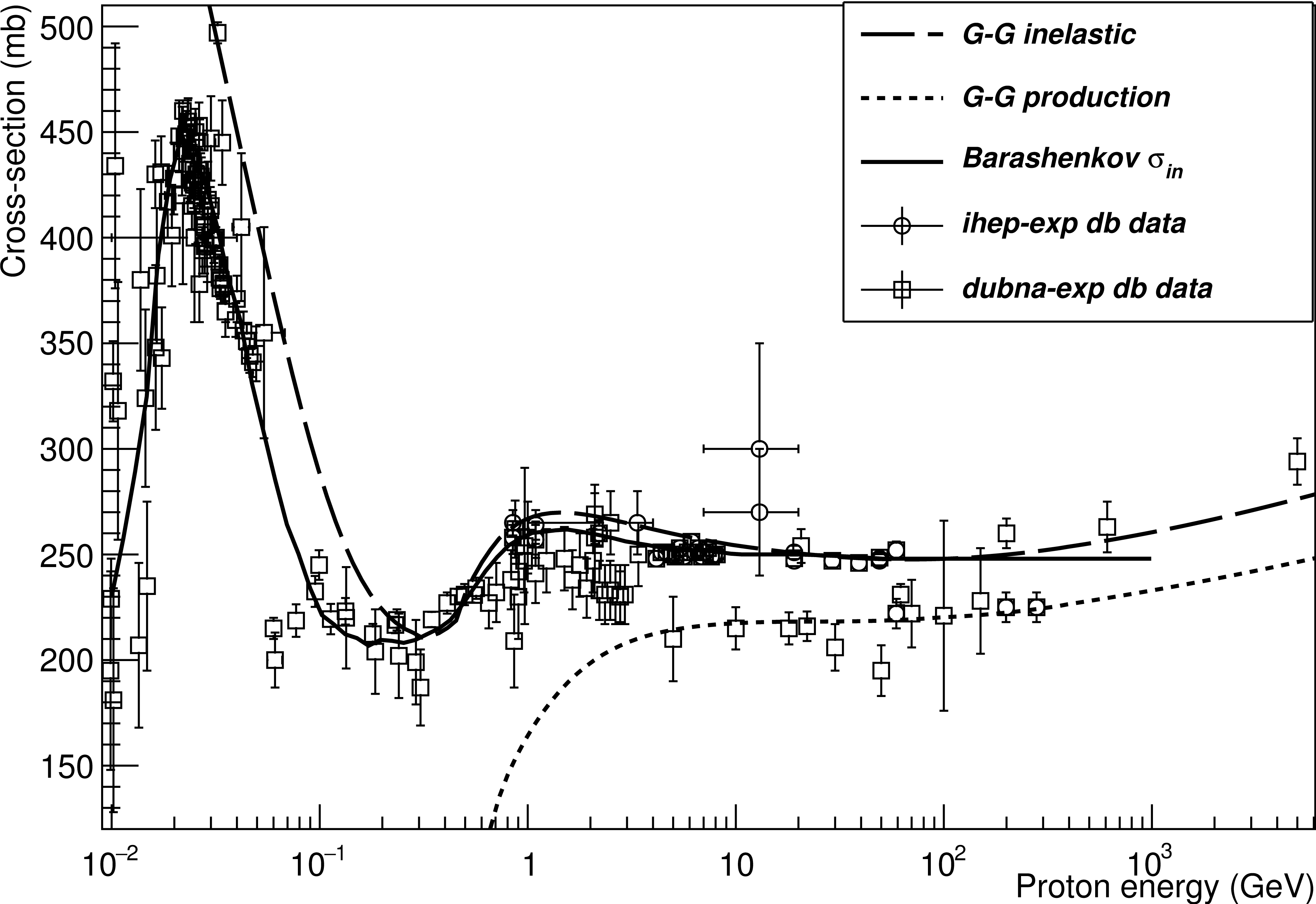Hadron-nucleon cross sections
The hadron-nucleon cross section parameterisations were tunned to the PDG-2016 data [ealParticleDGroup16]. Both total and elastic cross sections are parameterized for protons, anti-protons, pions, and kaons. For positively charged projectile a Coulomb barrier factor is applied, for negatively changed particles below laboratory kinetic energy 100 keV cross section is set to const value. For hyperons, charmed and bottom mesons and baryons scaling from proton and pion cross sross sections is applied.
Neutron-Nucleus cross sections
Neutron cross section data for elastic, inelastic, capture, and fission processes are available with the G4NDL4.6 dataset derived from the recent ENDF database. These data are used with all HP models. For fast access to the neutron cross sections for all target nuclei, the dataset G4PARTICLEXS4.0 is used in the default and many other reference Physics Lists.
Other Hadron-Nucleus cross sections
For protons and pions a special combination of cross sections from the Barashenkov interpolations [BT72, NEA] are used below 91 GeV and the Glauber-Gribov cross sections are used above. Glauber-Gribov cross sections are used for all other hadrons and ions.
The simplified Glauber model cross sections assume Gaussian-distributed, point-like nucleons and are given by [Gri09a, Gri09b]:
Here \(\sigma^{hA}_{tot}\), \(\sigma^{hA}_{in}\), and \(\sigma^{hA}_{el}\) are the total, inelastic and elastic cross sections, respectively.
The model is reduced to the selection of \(\sigma^{hN}_{tot}\) and \(R(A)\) values. The latest edition of PDG [Groom00] and parameterizations were used for \(\sigma^{hN}_{tot}\), including the total cross sections of \(p\), \(\bar{p}\), \(n\), \(\pi^{\pm}\), \(K^{\pm}\) and \(\Sigma^{-}\) on protons and neutrons For known cross sections on protons and neutrons, \(A\sigma^{hN}_{tot}=N_{p}\sigma^{hp}_{tot}+N_{n}\sigma^{hn}_{tot}\), where \(N_{p}\) and \(N_{n}\) are the number of protons and neutrons in the nucleus. The nuclear radius (the RMS radius of the nucleon Gaussian distribution), is parametrized as \(R(A) = r_{o}A^{\frac{1}{3}}f(A)\), \(r_{o} \sim 1.1 \ fm\), with \(f(A) < 1\) for \(A > 21\), and \(f(A) > 1\) for the case \(3 < A < 21\). Fig. 63 and Fig. 64 show the prediction of the Barashenkov and Glauber-Gribov model for total, inelastic and production cross sections of neutrons and protons on a carbon target. The production cross section is defined to be the difference between the inelastic and charge exchange cross sections.

Fig. 63 Total, inelastic and production cross-sections of neutrons on a carbon target in the energy range \(10^{-2}-10^3\) GeV. Experimental data (open and solid points) from [IHEP, NEA], lines correspond to the Glauber-Gribov model.

Fig. 64 Inelastic and production cross-sections of protons on a carbon target in the energy range \(10^{-2}-10^3\) GeV. Experimental data (open points and squares) are from [IHEP, NEA]. The solid and dashed lines correspond to the Barashenkov and Glauber-Gribov inelastic models, respectively. The dotted line shows the Glauber-Gribov production model.
Extraction of CHIPS kaon and hyperon nuclear cross sections
Alternative cross sections for kaons and hyperons incident upon nuclei are based on the parameterization by Kossov and Degtyarenko who developed them as part of the CHIPS package [DKW00a, DKW00b, DKW00c, Kos02]. This parameterization was developed using extensive data samples and contains a number of parameters which depend on the type of projectile. With 9.6 these cross sections were made independent of the CHIPS package and their interfaces made to conform to the hadronic standard in the toolkit.
- BT72
V.S. Barashenkov and V.D. Toneev. High Energy interactions of particles and nuclei with nuclei (In russian). 1972.
- DKW00a
P. V. Degtyarenko, M. V. Kossov, and H. -P. Wellisch. Chiral invariant phase space event generator, i. nucleon-antinucleon annihilation at rest. The European Physical Journal A, 8(2):217–222, jul 2000. URL: https://doi.org/10.1007/s100500070108, doi:10.1007/s100500070108.
- DKW00b
P.V. Degtyarenko, M.V. Kossov, and H.-P. Wellisch. Chiral invariant phase space event generator, ii. nuclear pion capture at rest. The European Physical Journal A, 9(3):411–420, dec 2000. URL: https://doi.org/10.1007/s100500070025, doi:10.1007/s100500070025.
- DKW00c
P.V. Degtyarenko, M.V. Kossov, and H.-P. Wellisch. Chiral invariant phase space event generator, iii. modeling of real and virtual photon interactions with nuclei below pion production threshold. The European Physical Journal A, 9(3):421–424, dec 2000. URL: https://doi.org/10.1007/s100500070026, doi:10.1007/s100500070026.
- ealParticleDGroup16
C. Patrignani et al. (Particle Data Group). 2016 review of particle physics. Chin. Phys. C, 40, 100001, 2016.
- Gri09a
V. M. Grichine. A simplified glauber model for hadron–nucleus cross sections. The European Physical Journal C, 62(2):399–404, may 2009. URL: https://doi.org/10.1140/epjc/s10052-009-1033-z, doi:10.1140/epjc/s10052-009-1033-z.
- Gri09b
V.M. Grichine. A simple model for integral hadron–nucleus and nucleus–nucleus cross-sections. Nuclear Instruments and Methods in Physics Research Section B: Beam Interactions with Materials and Atoms, 267(14):2460–2462, jul 2009. URL: https://doi.org/10.1016/j.nimb.2009.05.020, doi:10.1016/j.nimb.2009.05.020.
- IHEP(1,2)
IHEP:. Institute for high energy physics database, protvino, russia. http://wwwppds.ihep.su:8001/ppds.html. [Online; accessed 15-July-2023].
- Kos02
M.V. Kossov. European Physical Journal A, 14:265, 2002.
- NEA(1,2,3)
NEA:. Barashenkov cross sections from nuclear energy agency, france. http://www.nea.fr/html/dbdata/bara.html. [Online; accessed 12-December-2017].
- Groom00
D.E. et al. Groom. Review of Particle Physics. The European Physical Journal, C15:1+, 2000. URL: http://pdg.lbl.gov.